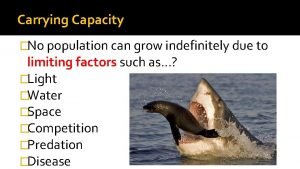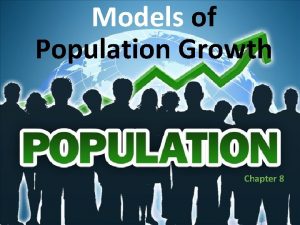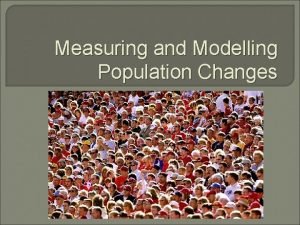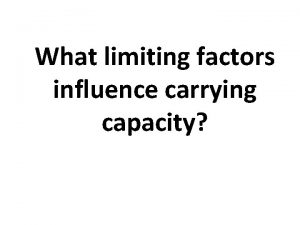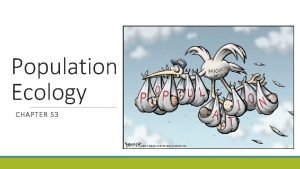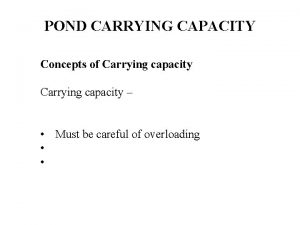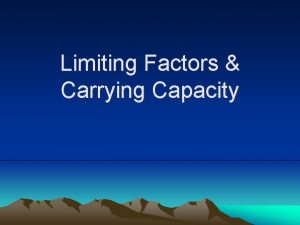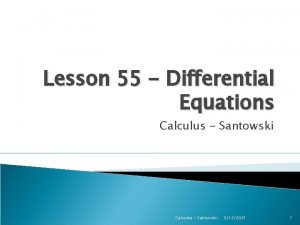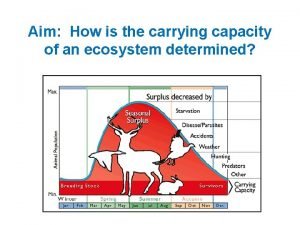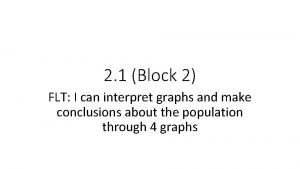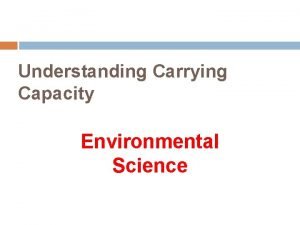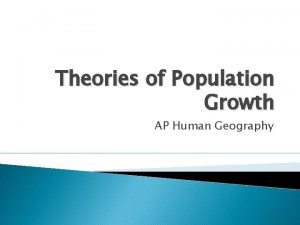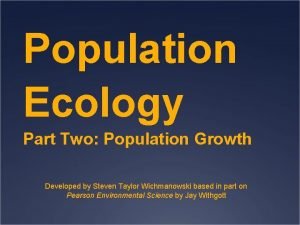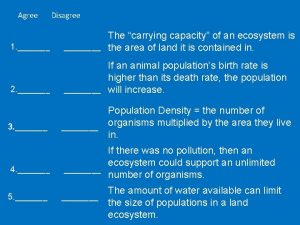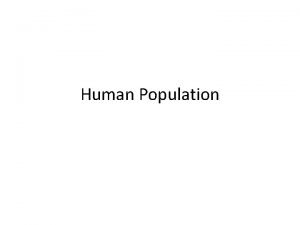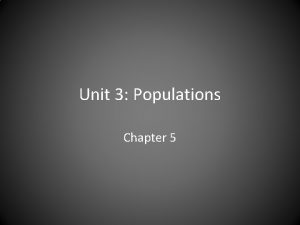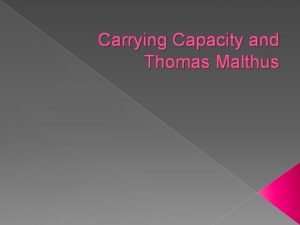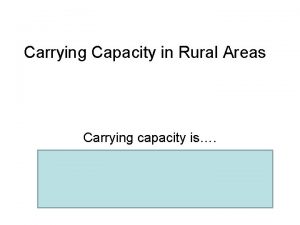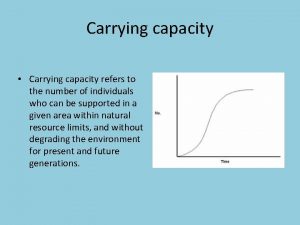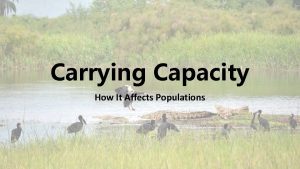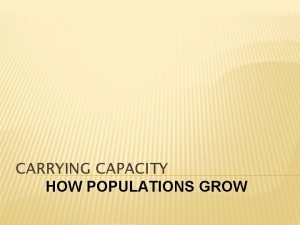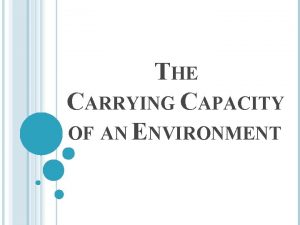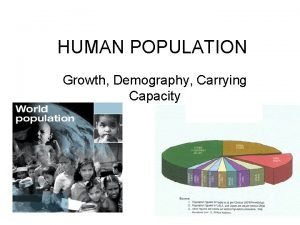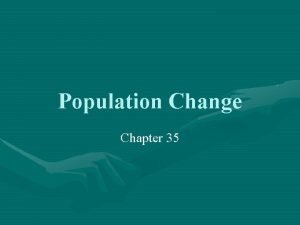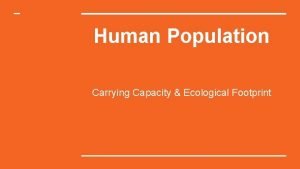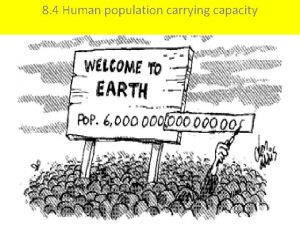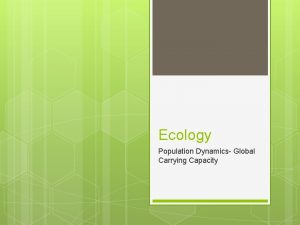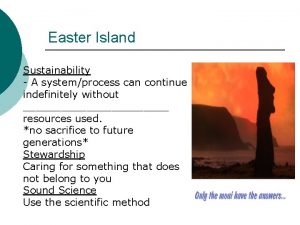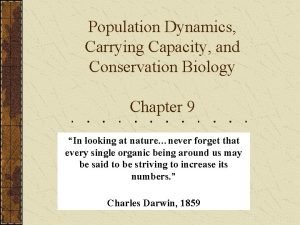Carrying Capacity No population can grow indefinitely due























- Slides: 23

Carrying Capacity �No population can grow indefinitely due to limiting factors such as…? �Light �Water �Space �Competition �Predation �Disease

Intrinsic rate of increase (r) �Rate of population growth with unlimited resources

4 Characteristics of Rapidly Growing Populations Timing of reproduction? Early in life 1.

4 Characteristics of Rapidly Growing Populations 2. Amount of time between generations? Short generation time

4 Characteristics of Rapidly Growing Populations 3. Length of reproductive lives? Long; can reproduce many times

4 Characteristics of Rapidly Growing Populations 4. # of offspring? (FECUNDITY) Many offspring (high fecundity)

Carrying Capacity (K) �Determined by biotic potential = maximum reproductive rate of a population in ideal conditions (capacity for growth) and �environmental resistance (factors that limit growth) �As population reaches carrying capacity, growth rate decreases because resources become more scarce, among other factors What happens to mortality? What happens to fecundity?

J-curve: Exponential Growth • In real-life situations, cannot last indefinitely!

S-curve (sigmoid)—logistic growth Notice it is exponential for the first part and then becomes S – shaped as limiting factors take effect

Dieback

Exponential Growth Equation The Drama Correlation Law Nt = N o rt e

N 0 = Initial population size r = rate of growth e = a constant (2. 7) t = amount of time Nt = Final population size This is also how you calculate compound interest

�Consider a population of mice that has an initial population size of 20 individuals. The intrinsic rate of growth for mice is r=0. 2 (or 20%), meaning each mouse produces a net increase of 0. 2 mice each year. Predict the size of the mouse population 5 years from now.

rt e �Nt = No (0. 2)(5) �Nt = (20) (2. 7 ) 1 �Nt = (20) (2. 7 ) �Nt = 54. 4 mice

rt e �Nt = No (0. 2)(10) �Nt = (20) (2. 7 ) 2 �Nt = (20) (2. 7 ) �Nt = (20) (7. 4) �Nt = 147. 8 mice

rt e �Nt = No (0. 2)(20) �Nt = (20) (2. 7 ) 4 �Nt = (20) (2. 7 ) �Nt = 1092 mice

Density Dependent Factors Will change intensity depending on the density of the population �Competition �Predation �Diseases �Parasitism

Density Independence Will have the same intensity depending on the density of the population �Natural: Floods, hurricanes, fire �Anthropogenic: Pollution, habitat destruction

Video: Texas Mosquito Mystery Crash Course #2 (11: 52 �www. youtube. com/watch? v=RBOsqm. BQBQk

4 Types of Population Fluctuations 1. Stable—fluctuates slightly above and below carrying capacity �Tropical Rainforest—temps/rainfall stay steady

2. Irrupt—Usually stable, but sometimes explodes and then crashes �Algae, insects—due to seasonal changes, nutrient availability

3. Cyclic—Rise and fall in predictable pattern �Predator/prey Video—Lynx and hare “epic hunting chase” 2: 53 https: //www. youtube. com/w atch? v=swi. SMSWgb. KE

4. Irregular—no recurring pattern �Chaos in the system, or just not yet understood?
 Can a population grow indefinitely
Can a population grow indefinitely Carrying capacity population
Carrying capacity population Relationship between population and carrying capacity
Relationship between population and carrying capacity Limiting factor definition
Limiting factor definition Population
Population Carrying capacity of pond
Carrying capacity of pond Whats carrying capacity
Whats carrying capacity Define differential equation
Define differential equation The information carrying capacity of a hologram is
The information carrying capacity of a hologram is Bcfc wagon
Bcfc wagon Can less than 150 minnows live in this lake
Can less than 150 minnows live in this lake Exponential growth and carrying capacity
Exponential growth and carrying capacity Carrying capacity environmental science
Carrying capacity environmental science Ernst ravenstein ap human geography
Ernst ravenstein ap human geography Population overshoot
Population overshoot Carrying capacity
Carrying capacity Carrying capacity
Carrying capacity Carrying capacity
Carrying capacity Thomas malthus carrying capacity
Thomas malthus carrying capacity Magnetic field current
Magnetic field current Design capacity and effective capacity examples
Design capacity and effective capacity examples Stack smashing example
Stack smashing example Ha i lati uguali a due a due e tutti gli angoli retti
Ha i lati uguali a due a due e tutti gli angoli retti Liberty chapter 20
Liberty chapter 20
